How to Cook Sockeye Salmon
This post may contain affiliate links. Please read the disclosure policy.
Learn how to cook sockeye salmon so it’s moist and flavorful! Wild sockeye is a healthy and delicious dinner idea you can prepare in minutes. Perfect for baking, grilling and more!
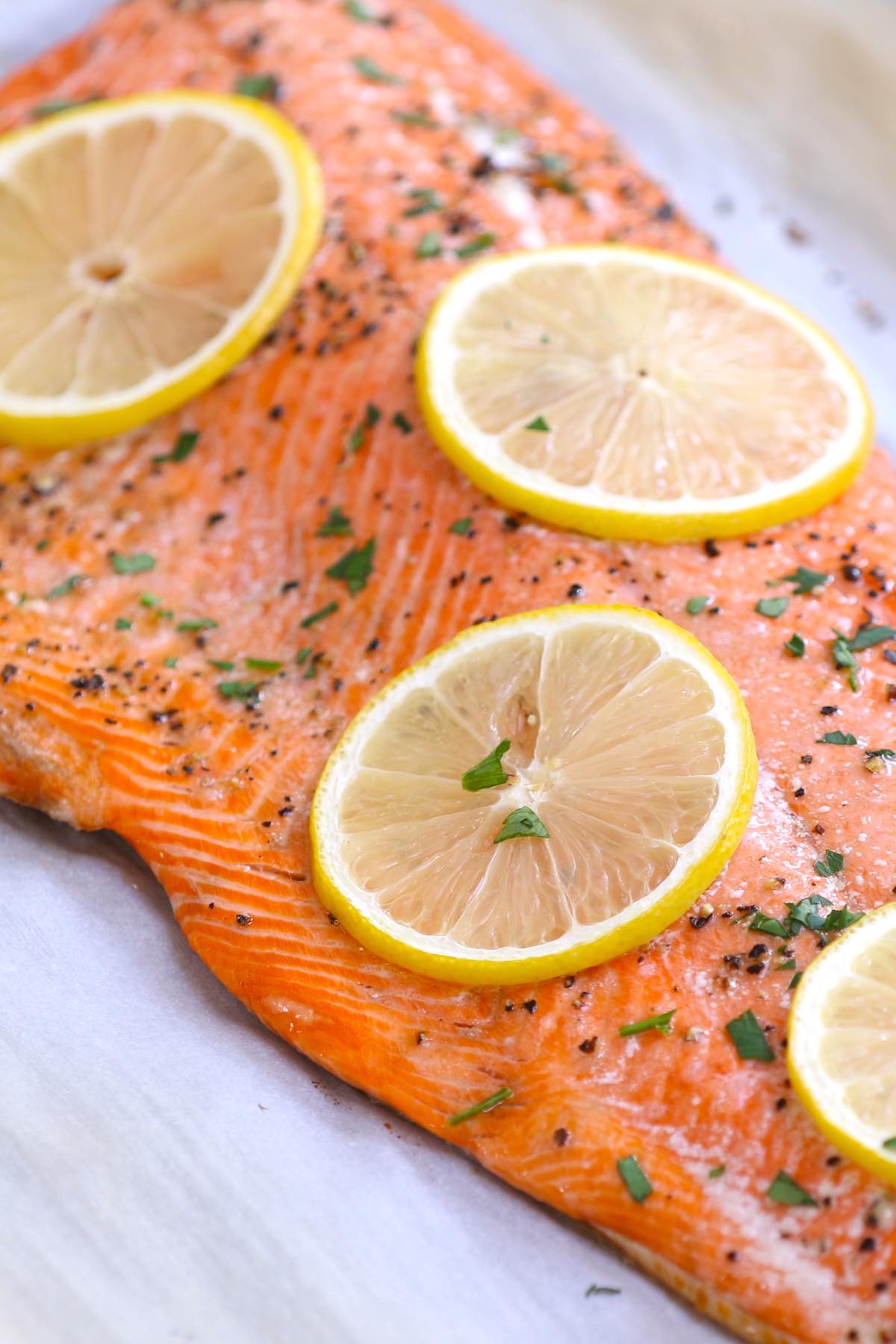
Let’s agree on one thing: it’s hard to beat fresh sockeye salmon! This incredible fish is prized for its rich flavor and health benefits. Plus, you can cook it many different ways including baking, grilling and pan frying.
Today, we’re covering everything you need for moist and flavorful sockeye. What are our valued readers saying about this sockeye salmon recipe? “5 STAR”, “Perfect recipe!”, “Tried it. Loved it!” So friends … let’s get started!
What is Sockeye Salmon
Sockeye is one of the most sought-after types of salmon with deep red flesh and a rich, buttery flavor. It’s sometimes called red salmon or blueback for its color, which is blue in the ocean and red upon returning to spawning grounds.
Unlike many other varieties being sold, sockeye is exclusively wild-caught and not farmed. It’s the third most common Pacific salmon species after pink and chum salmon, being caught from California all the way up to the Bering Sea in Alaska. You can buy fresh sockeye in season from May through September, and frozen sockeye the rest of the year.
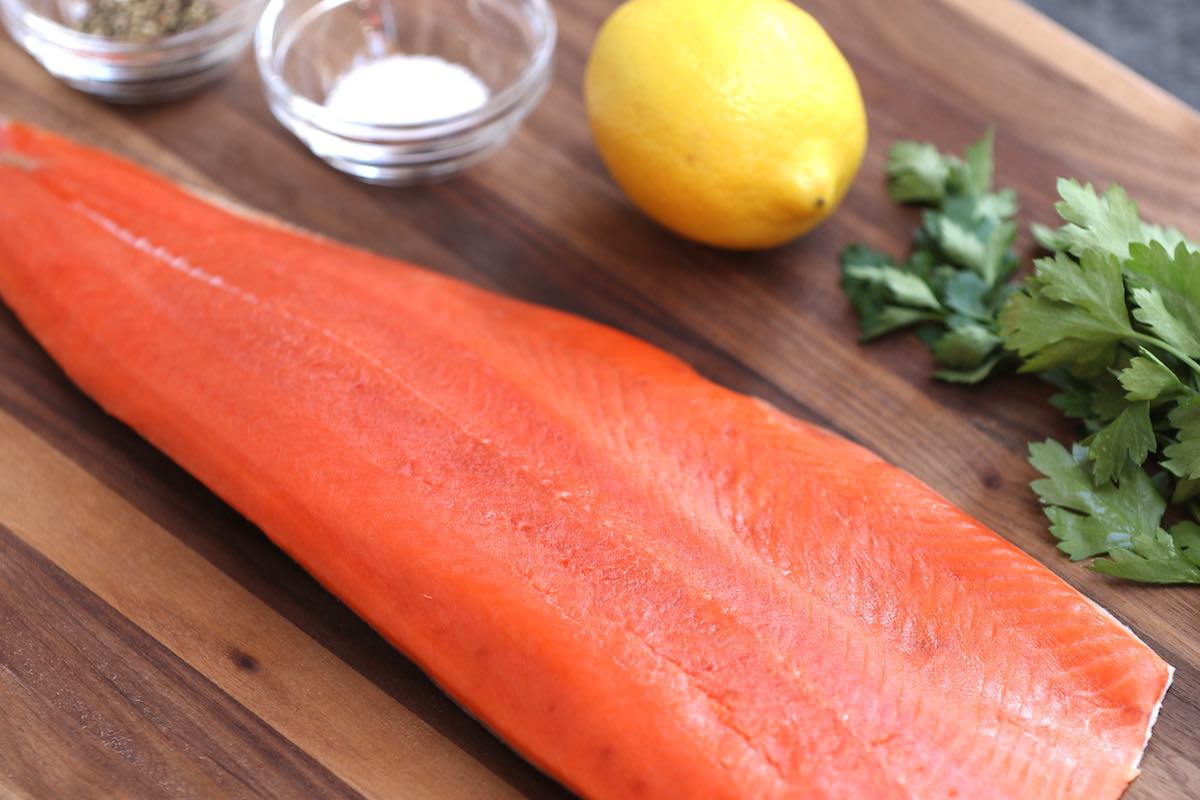
Sockeye Salmon vs Atlantic Salmon
Ever wonder what the difference is between Atlantic and sockeye salmon? After all, you may see them both side-by-side at the fish counter at different price points. The bottom line is that sockeye has the upper hand in terms of flavor and nutrition because it feeds on plankton and small crustaceans, whereas Atlantic salmon get pellets from a farm. Here’s a comparison of the two:
| Sockeye Salmon | Atlantic Salmon | |
| Catch location | Pacific | Atlantic |
| Catch method | 100% wild-caught | 100% farmed |
| Flesh color | Deeper orange or red | Light orange or pink |
| Nutrition | Lean and very nutritious | Fattier and less nutritious |
| Flavor | Rich and buttery flavor | Mild flavor |
| Pollution | Low in contaminants | High in contaminants |
The main redeeming value of Atlantic salmon? It’s less likely to dry out during cooking with its high fat content. Otherwise, sockeye is the best choice.
Health Benefits
We all want to live a healthier life, right? Nutritionists tend to agree that sockeye salmon is a great choice. It has the highest omega-3 fatty acids (DHA) of any fish at 2.7 grams per 100 grams with benefits including heart and brain health as well possibly less inflammation according to Healthline. Unlike farmed salmon, sockeye is low in the pro-inflammatory omega-6 fatty acids that inhibit omega-3.
Healthline also outlines the abundant vitamins, minerals and antioxidants in sockeye. You get significant amounts of vitamins A, B3, B6, B12 and D with benefits for immunity, disease protection and thyroid function. Sockeye is also a rich source of selenium and also contains potassium, calcium and the antioxidant astaxanthin. Plus, it has one of the lowest mercury levels of all fish species.
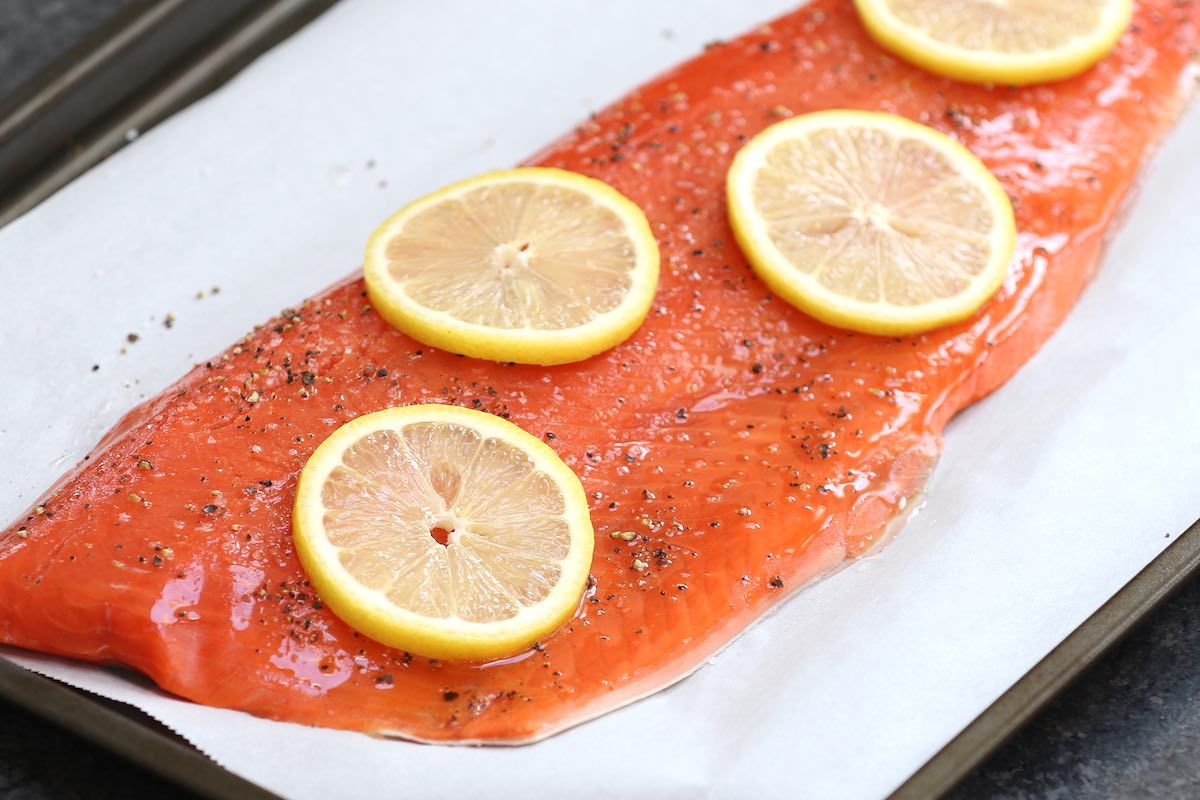
How to Cook Sockeye Salmon
First things first. You want to remove the salmon from the refrigerator 30 to 60 minutes ahead of time if possible. This simple step takes the chill off so the sockeye cooks faster for moister fish. If you are using frozen sockeye, it’s crucial to thaw it completely before use.
Next, pat dry with paper towels. Then run your fingers along the surface to check for bones, using fish tweezers to remove any that you find. Finally, rub on all sides with oil followed by the seasonings and place on a baking sheet lined with parchment or foil.
TIP: Tuck thin tail sections underneath to make a double layer, so they cook at a similar speed as the thick section.
With the preparation our of the way, let’s explore the different ways to cook sockeye:
- Baked: My preferred cooking method. Preheat your oven to 375°F and line a baking sheet with parchment paper or foil. Place the fish skin-side down and bake for 8-10 minutes.
- Grilled: Preheat your grill to medium-high or 375°F. Thoroughly clean and oil the grill grates to reduce sticking. Season the fish and place on the grill skin-side up with the lid open for 4 minutes per inch of thickness (rotating halfway to get crosshatch grill marks). Flip and cook another 4-5 minutes with the lid closed.
- Pan Fried: Pan frying is not ideal due to the risk of overcooking. If there are no other options, you can proceed using a nonskillet over medium heat. After 5 minutes have passed, start checkiung doneness every minute using an instant-read thermometer.
- Sous Vide: This cooking method produces perfectly moist sockeye. After vaccum sealing the fillet, place in a 120°F (49°C) water bath to cook for about 45 minutes or one hour for thick fillets.
TIP: Since fish is quite delicate, you want to get in the habit of using a fish spatula to transfer the sockeye easily to a serving dish. You can also use it to strip the skin off if you like.
Sockeye FAQ
What’s the best way to cook sockeye salmon? Baking in the upper middle section of the oven is the best option, as the indirect heat makes it less likely to overcook. You also get light browning for an attractive presentation.
Do I need to wrap sockeye in foil? Salmon skin can stick easily in the oven, so wrapping in foil helps prevent sticking for easy cleanup. However, you don’t get the benefits of a nice brown crust on the surface. Another option is placing foil or parchment beneath the salmon only.
What is the white stuff on salmon? As salmon cooks, a protein called albumin solidifies as the muscle fibers contract. While it’s not so visually appealing, albumin is harmless and flavorless. By sprinkling freshly chopped herbs and seasonings on top, you can make it less noticeable!
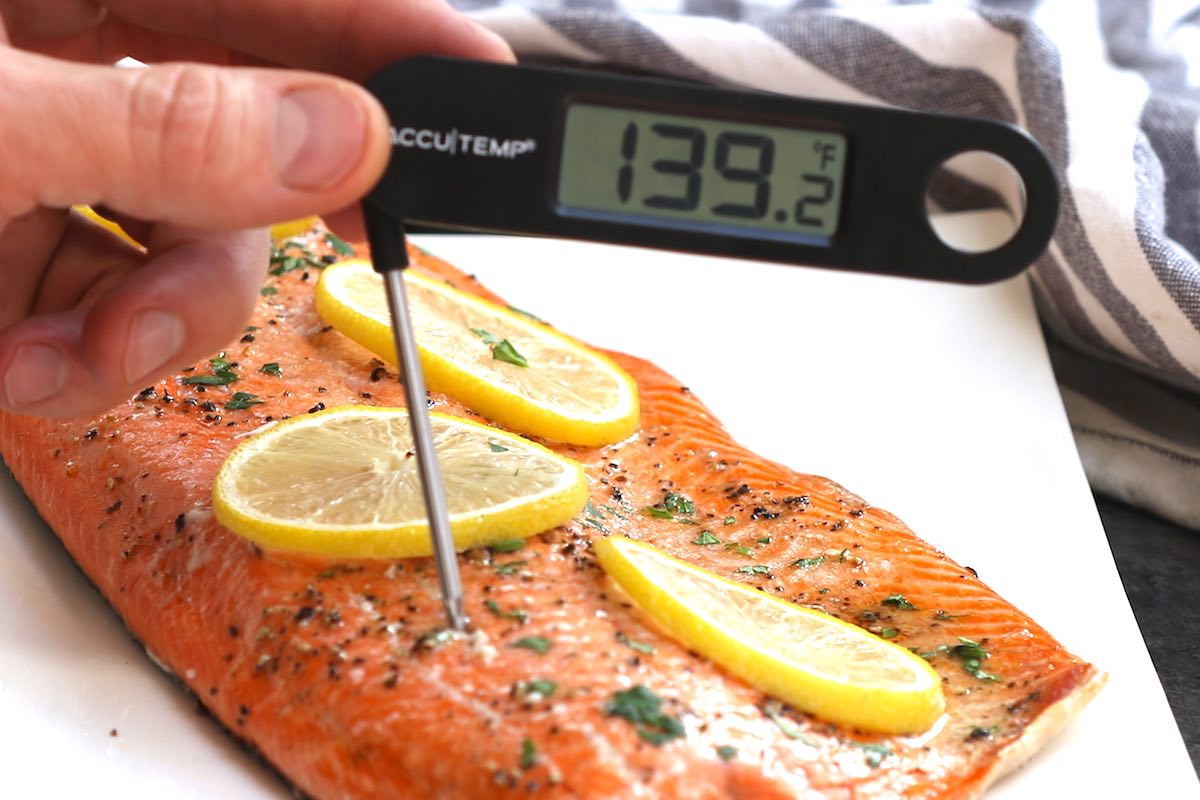
How Long to Bake Salmon
My rule of thumb for sockeye is 10 minutes per inch of thickness (in the thickest section) to reach medium-rare, but it also depends on how cold the fish is before cooking. If the sockeye has been at room temperature for one hour, it may only need 7 to 8 minutes per inch.
Remember that sockeye fillets are thinner and leaner than most other varieties such as Coho, Pink or King salmon (Chinook). That means it’ll cooks faster: thick Coho salmon might be take 15 to 20 minutes, while sockeye will only need 10 minutes.
When Is It Done?
The best way to check doneness is with an inexpensive gadget called an instant-read thermometer. It’ll give you quick readings of the fish’s internal temperature:
- Rare sockeye 120°F (49°C)
- Medium-rare sockeye 125°F (52°C) → recommended
- Medium sockeye 130°F (54°C)
Note the temperature will rise another 5°F after cooking. Also, these temps are 5°F lower than what you’d use for farmed salmon, which can withstand more cooking due to its higher fat content. I don’t suggest cooking sockeye beyond 130°F before removing from the heat.
The USDA states fish should be cooked to 145°F to kill bacteria, but sockeye is so lean that it’ll be chewy by the time it reaches that temperature!
If you don’t have a thermometer: Slide the tines of a fork (or a knife tip) into the thickest section of the fish and twist slightly to expose the flesh. When done, it should be slightly translucent and just barely flaking like this:
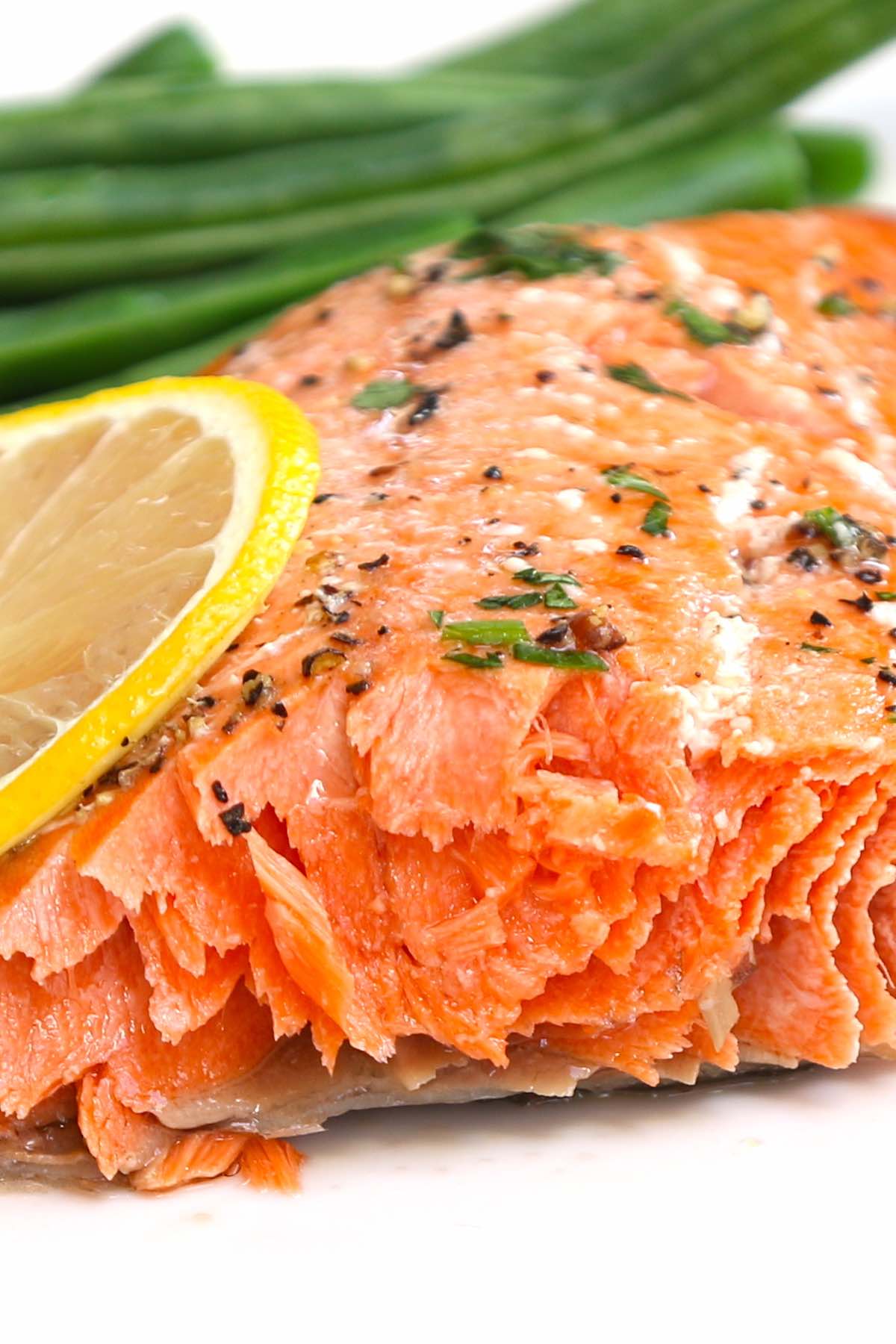
Serving Ideas
Sockeye pairs beautifully with many side dishes including mashed potatoes, boiled potatoes, steamed rice, cauliflower rice, boiled broccoli, green beans, carrots, parsnips, cabbage and many other veggies.
In terms of condiments, there are many options such as pico de gallo, mango salsa, tartar sauce, teriyaki sauce, lemon butter sauce, Hollandaise sauce and more.
Storing Leftovers: You should refrigerate leftover sockeye within two hours. According to the USDA, you can store them in an airtight container in the fridge for up to 3 to 4 days. Reheat gently over medium-low heat on the stovetop, or in a 350°F (177°C) oven for no more than 5 minutes just until warmed. Do not microwave.
More salmon recipes:
Baked Sockeye Salmon
Ingredients
- 1 ½ pounds sockeye salmon fillets, skin-on or skin-off
- 1 tablespoon extra virgin olive oil
- 1 lemon, thinly sliced
- 1 teaspoon kosher salt, or to taste
- ½ teaspoon black pepper, freshly ground
- 1 tablespoon fresh herbs (parsley, dill or other), chopped
Instructions
- Optional: Remove the sockeye from the refrigerator 30 to 60 minutes ahead of time. While not required, this step will take the chill off and promote even cooking for moister fish.
- Preheat oven to 375°F, placing the oven rack in the upper middle position. Line a baking sheet with parchment paper or foil and set aside.
- Place the sockeye on a work surface. Pat dry with paper towels to remove any excess moisture. Run your fingers along the surface to check for bones and use fish tweezers to grasp any and pull vertically to remove.
- Rub all sides with the olive oil. Then rub with salt and pepper. Put the salmon skin-side down on the prepared baking sheet. Place 4 or more lemon slices on top.
- Bake for 8 to 10 minutes per inch of thickness. Start checking doneness after 7 minutes by inserting an instant-read thermometer into the center of the thickest section. Rare is 120°F / 49°C, while medium-rare is 125°F / 52°C (recommended) and medium is 130°F / 54°C. If you don't have a thermometer, slide a knife tip into the thickest section and twist slightly to expose the flesh, which should be slightly translucent when done.
- Remove from the oven. Use a fish spatula to strip off the skin if desired. Then sprinkle fresh herbs on top.
- Use the spatula to transfer the fillet to a serving dish. Serve warm.
Notes
- Note that the internal temperature of the salmon will rise an additional 5°F out of the oven.
- During baking the fish may exude a white substance called albumin. This natural protein akin to egg white is harmless and flavorless. If you find it unappetizing, sprinkling fresh herbs on top will help to cover it up.
- Grilled sockeye: Preheat the grill to 375-400°F and thoroughly oil the grates. Prepare the fish as above and place it skin-side up for 4 minutes with the lid open. Flip and cook for 4-5 minutes more with the lid closed until done.
- Make Ahead: Unfortunately sockeye does not reheat well due to its lean texture. If you must make it ahead, it’s best to undercook it slightly and reheat for 5-7 minutes over low-medium heat in a skillet. Do not use the microwave.
Please read our nutrition disclaimer.
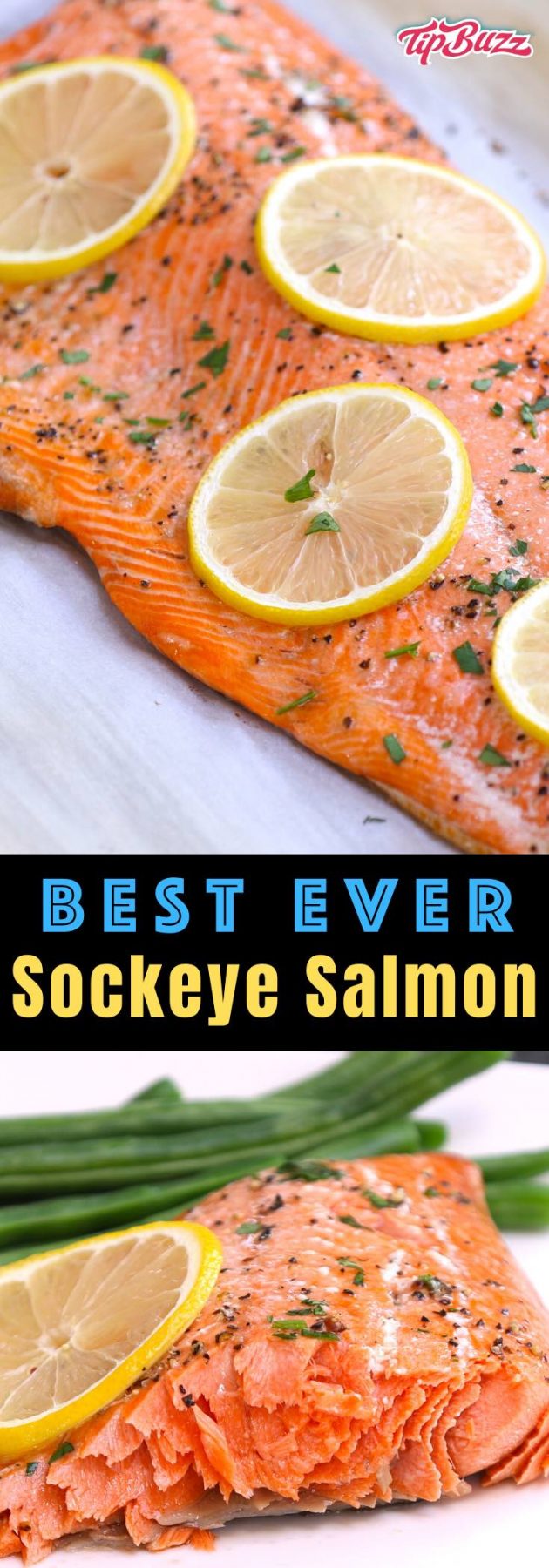
© TIPBUZZ. Images and text on this website are copyright protected. Please do not post or republish without permission. If you want to republish this recipe, please link back to this post. This post may contain affiliate links. Read the disclosure policy here.
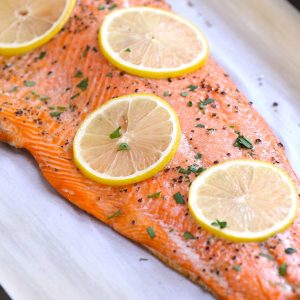
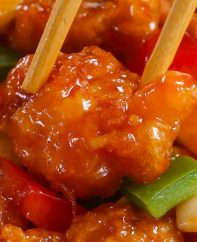

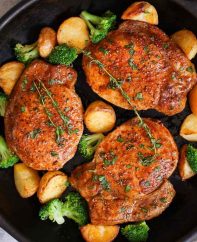
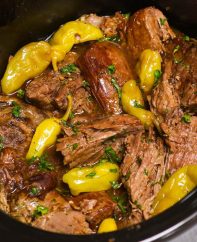
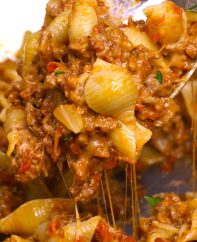


5 STAR!
Hi Mark, Thanks and glad you enjoyed!
Perfect recipe. If I followed the recipe with the fish I purchased, it would have been overdone by a mile. This recipe is simple and elegant and the fish is cooked just right, moist, allowing for the delicate taste of the fish to come through.
Hi there, Thanks for your feedback. Farmed salmon and sockeye behave quite differently, so it’s important to get the the right recipe. Glad it was a success!
Great recipe!
Your comment about sockeye salmon being not farmed “unlike most other varieties” is misleading for a US audience. In the US, only Atlantic salmon and GMO salmon is farmed. Chinook/king, coho/silver, sockeye/red, pink/humpy, and chum/dog salmon are all wild-caught in the US. Additionally, any Alaska-caught salmon is definitely wild since fish farming of any kind is illegal in Alaska.
Canada farms coho and Chinook as well as Atlantic salmon.
It’s very frustrating for Alaskans to see misleading information like this being published because it confuses consumers and leads to decisions not to buy Alaskan seafood, which leads to fishing families being put out of business.
Hi Emily, Thanks for your comment and it’s a great point! I updated to state “many” other varieties instead of most. I guess the challenge is that supermarkets are selling lots of farmed salmon from other countries now, just like with shrimp. While some other Alaska-sourced varieties are indeed wild, the vast majority of non-sockeye salmon for sale is farmed.
Tried it. Loved it!
Hi Dave, Great to hear and thanks so much for your feedback!
Easy and flavorful this is my favorite kind of recipe!
Hi Beth, Thanks for your comment and glad you enjoyed it!